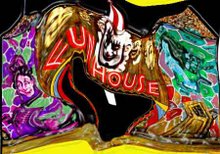Day 2 First Day in Cairo Part 2, The Egyptian Museum
We piled back into the bus and passed more monuments and people selling their wares on the way to the Egyptian Museum.
I was quite surprised by the condition of the buildings. My vision of Egypt had been built in the 60s when our media showed images of wealthy sheiks and snazzy night clubs. I hadn't expected poverty and earthquake damage.
The famous Egyptian Museum is a pink building with a fence around it. Our guide, Yasser, talked about how he and lots of academics ran to barricade the building during the Arab Spring to make sure the artifacts weren't looted.
The museum is huge with over 100 rooms so we did not have enough time to do a thorough job of examining everything. I will include objects that I saw that seemed interesting. Unfortunately there were not a lot of tags and of course there was so much crammed into the space that it was like going to one of those big antique shops where there is so much stuff that you feel like a treasure is around every corner.
The above picture is simply to give a sense of the atmosphere of the museum.
I took many pictures of things I found interesting, but will only put a couple of them here.
The stela below is Ptolemy V offering the sekhet (symbol of the fields) to the bull Buchis (sacred to the war god Montu who is represented by the falcon above the bull).
There were many rooms like this one with so many things of interest to look at. I wish I had had more time.
And of course there were sarcophagi.
I thought the sarcophagus below was particularly beautiful. I think this is the sarcophagus of Ahmed Meritamun (18th Dynasty from the reign of Amenhotep I 1525-1540 BCE). She may have been Amenhotep I's wife. You can't see it in the picture, but she is holding papyrus shaped scepters that symbolize youth.
This throne belonged to the princess Satamun (18th Dynasty) the daughter of Amenhotep III and Queen Tiy. She personally placed it in the Tomb of Yuya and Thuya (her grandparents) in the Valley of the Kings. The back rest shows a young girl presenting Satamun in a wig tied with a ribbon and crowned by papyrus (the symbol of rebirth) with a necklace.
And below are funerary masks of wife and husband Thuya and Yuya.
One of the mummies (I think it is Yuya.)
Thuya's outer sarcophagus.
There were several rooms with papyrus manuscripts along the walls. The birds in this one were quite fetching.
There were also lots of cases of small figures. These are (u)shabtis, small figures placed in the tombs to be servants to the dead in the afterlife.
One of my biggest thrills was to see this scorpion goddess which I used to fixate on in the National Geographic articles. Isis (with the throne on her head above left) watches over the liver of Tutankhamun. Serqet (Selket) the scorpion goddess protects the intestines.
Tut's throne was also featured in National Geographic.
The picture on the back of the throne shows Tutankhamun and his wife Ankhsenamun who spreads ointment on her husbands shoulder. The sun disk spreading its rays over the couple (Aten) suggests the throne was made early in Tutankhamun's reign, before monotheism failed and worship returned to Amun and other gods.
The painted limestone head of Queen Hatshepsut is one of the most notable pieces in the museum. She served as regent to her nephew Thutmosis III in the 18th Dynasty (New Kingdom) and then did not turn over the reign, ruling in peace for 21 years (1479-1458 BCE). After her death, Thutmosis III systematically tried to eradicate her from the monuments. The head was part of an enormous statue that stood at her temple at Deir al Bahri. She is given male attributes (including the false beard) to legitimize her ruling as king.
Below is the statue of Khafra (reign 2520-2494 BCE). The symbol of the Sema-tauy on the side of the throne represents the uniting of two lands (Upper and Lower Egypt). The sculpture is carved in diorite and extremely hard stone
Below seems to be a figure making bread.
One of my favorite pieces in the museum is this fourth dynasty painting on stucco of the Geese of Maydum from the mastabas of Nofermaat and Itet. The painting is so precise and crisp and the color is gorgeous.
Below is the only depiction we have of Khufu, the builder of the great pyramid at Giza. It is tiny and carved in ivory. Herodotus in his Histories describes Khufu as cruel and blasphemous and Egyptian texts also seem to describe him as proud and evil.
This is a statue of Hetepdief from the 2nd-3rd dynasty. He was a funerary priest and is shown kneeling in reverence to the dead kings for whom he was responsible after their deaths.
This is a statue of Hathor (in the form of a cow) standing over Amenhotep II (1428-1397 BCE). It was found at Deir Al-Bahri in the temple of Thutmosis III (1479-1425 BCE). In the shrine you can just see Thutmosis III pouring an offering and burning incense before Amun-Ra.
One of the colossal statues of Akhenaten from East Karnak. The major change in artistic style has caused much discussion in the Egyptology community.
Soon it was time to leave the museum, because some of us had signed up for a visit to the Suq (market) and a dinner out. We climbed back into our bus and drove through the city again.
Crossing the Nile, we found ourselves back at the hotel.




































No comments:
Post a Comment